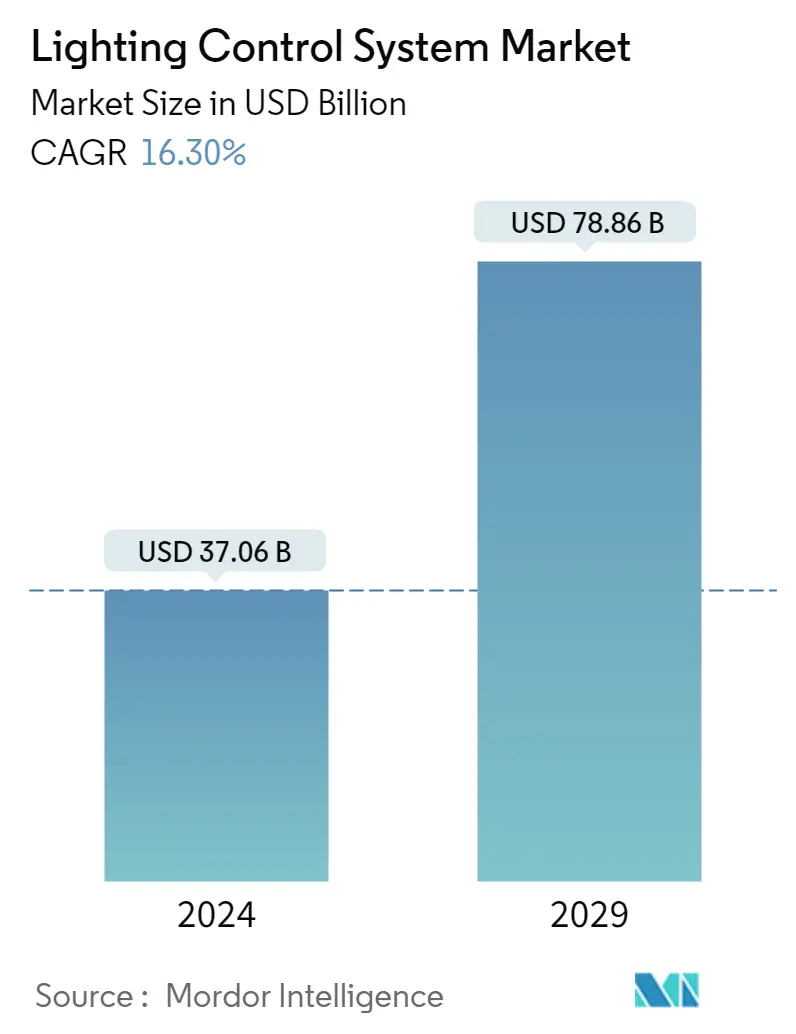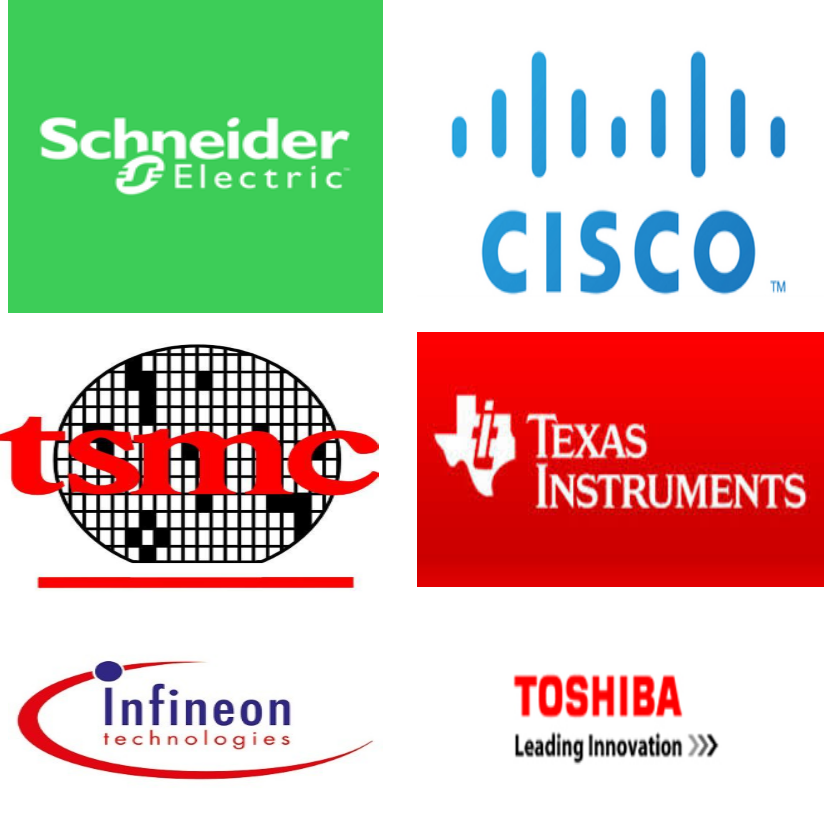Market Size of Lighting Control System Industry

| Study Period | 2019 - 2029 |
| Market Size (2024) | USD 37.06 Billion |
| Market Size (2029) | USD 78.86 Billion |
| CAGR (2024 - 2029) | 16.30 % |
| Fastest Growing Market | Asia Pacific |
| Largest Market | North America |
Major Players
*Disclaimer: Major Players sorted in no particular order |
Lighting Control System Market Analysis
The Lighting Control System Market size is estimated at USD 37.06 billion in 2024, and is expected to reach USD 78.86 billion by 2029, growing at a CAGR of 16.30% during the forecast period (2024-2029).
The market is moving toward the adoption of the Internet of Things (IoT), with the increasing usage of smart devices, such as smartphones, tablets, etc. As the lighting control market is finding its applications in IoT-connected devices, the increase in adoption is influencing a positive growth of the market.
- The improved connectivity and advancements in technologies solutions have increased the adoption of smart lighting controlling system, globally. Wireless technologies, such as ZigBee and bluetooth, have made installations of smart lighting controlling system seamless across various spaces.
- Moreover, the concept of smart cities is also increasing in different regions and this movement is supported by many government initiatives. As a smart city consists of a connected system, the general lighting application in the smart city requires automated lighting systems. These automated lighting systems use sensor-based control systems.
- For instance, in April 2018, the Council of Australian Governments Energy Ministers have announced to replace halogen lamps with LED lamps to improve energy efficiency.
- However, on the flip side, wireless connections can be unreliable at times and ongoing maintenance are the factors hampering the overall growth of the market. The initial set up cost is also high, which is a major challenge in the large-scale adoption of lighting control systems.
Lighting Control System Industry Segmentation
Smart lighting control systems improve energy efficiency and performance. These systems have countless applications across diverse verticals, like aircraft, automobiles, home appliances, etc. Smart lighting controls have been increasingly adopted in an effort to reduce energy consumption.
| By Type | |||||||
| |||||||
| Software |
| By Communication Protocol | |
| Wired | |
| Wireless |
| By Application | |
| Indoor | |
| Outdoor |
| Geography | ||||||||
| ||||||||
| ||||||||
| ||||||||
|
Lighting Control System Market Size Summary
The lighting control system market is experiencing significant growth, driven by the increasing integration of Internet of Things (IoT) technologies and smart devices. This market is evolving with the adoption of advanced connectivity solutions like ZigBee and Bluetooth, which facilitate seamless installations across various environments. The concept of smart cities, supported by government initiatives, is further propelling the demand for automated lighting systems that utilize sensor-based control mechanisms. These systems are essential for managing lighting in interconnected urban infrastructures, which are becoming more prevalent as urbanization continues to rise. Despite the challenges posed by unreliable wireless connections and high initial setup costs, the market is poised for expansion as cities worldwide seek to enhance energy efficiency and reduce light pollution through smart lighting solutions.
The Asia-Pacific region, particularly China and India, is witnessing rapid growth in the lighting control system market due to extensive infrastructure development and a shift towards energy-efficient lighting solutions. The increasing awareness of the benefits of connected lighting systems is enabling significant cost savings through optimal energy consumption. In India, the transition from conventional lighting to LED and smart lights presents substantial opportunities for both international and domestic manufacturers. The market is highly competitive, with major players like Texas Instruments, Schneider Electric, and Philips NV employing strategies such as product launches, research and development investments, and strategic partnerships to maintain their market positions. These efforts are crucial as the industry aims to meet the growing demand for intelligent lighting controls in various sectors, including commercial and residential buildings.
Lighting Control System Market Size - Table of Contents
-
1. MARKET DYNAMICS
-
1.1 Market Overview
-
1.2 Introduction to Market Drivers and Restraints
-
1.3 Market Drivers
-
1.3.1 Growing Demand For Energy-efficient Lighting Systems
-
1.3.2 Growing Modernization And Infrastructural Development
-
-
1.4 Market Restraints
-
1.4.1 High Cost of Installation
-
-
1.5 Value Chain / Supply Chain Analysis
-
1.6 Industry Attractiveness - Porter's Five Forces Analysis
-
1.6.1 Threat of New Entrants
-
1.6.2 Bargaining Power of Buyers/Consumers
-
1.6.3 Bargaining Power of Suppliers
-
1.6.4 Threat of Substitute Products
-
1.6.5 Intensity of Competitive Rivalry
-
-
-
2. MARKET SEGMENTATION
-
2.1 By Type
-
2.1.1 Hardware
-
2.1.1.1 LED Drivers
-
2.1.1.2 Sensors
-
2.1.1.3 Switches and Dimmers
-
2.1.1.4 Relay Units
-
2.1.1.5 Gateways
-
-
2.1.2 Software
-
-
2.2 By Communication Protocol
-
2.2.1 Wired
-
2.2.2 Wireless
-
-
2.3 By Application
-
2.3.1 Indoor
-
2.3.2 Outdoor
-
-
2.4 Geography
-
2.4.1 North America
-
2.4.1.1 United States
-
2.4.1.2 Canada
-
-
2.4.2 Europe
-
2.4.2.1 United Kingdom
-
2.4.2.2 Germany
-
2.4.2.3 France
-
2.4.2.4 Italy
-
2.4.2.5 Spain
-
2.4.2.6 Rest of Europe
-
-
2.4.3 Asia-Pacific
-
2.4.3.1 China
-
2.4.3.2 Japan
-
2.4.3.3 India
-
2.4.3.4 South Korea
-
2.4.3.5 Rest of Asia-Pacific
-
-
2.4.4 Rest of the World
-
2.4.4.1 Latin America
-
2.4.4.2 Middle-East & Africa
-
-
-
Lighting Control System Market Size FAQs
How big is the Lighting Control System Market?
The Lighting Control System Market size is expected to reach USD 37.06 billion in 2024 and grow at a CAGR of 16.30% to reach USD 78.86 billion by 2029.
What is the current Lighting Control System Market size?
In 2024, the Lighting Control System Market size is expected to reach USD 37.06 billion.

